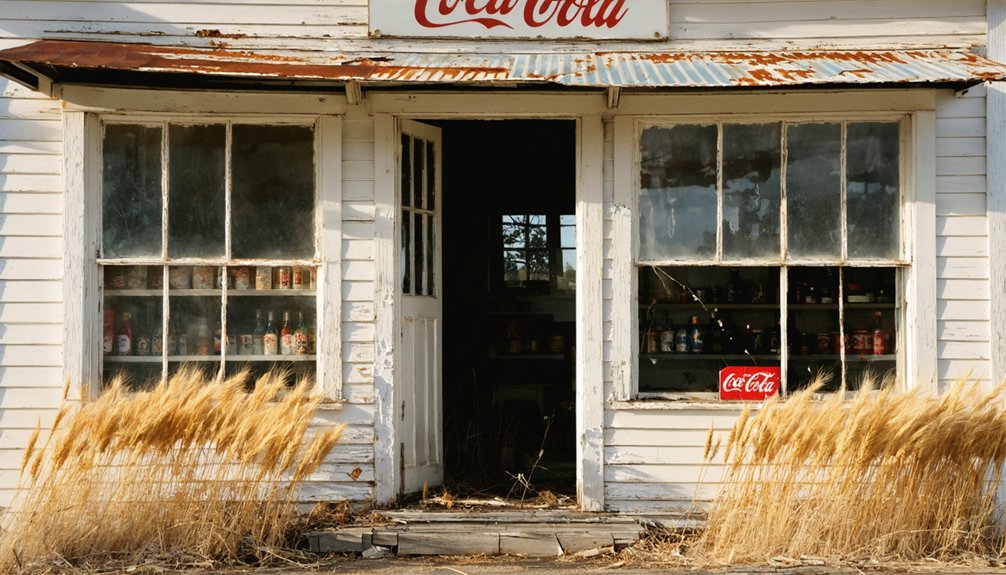You’ll find Summit, South Dakota’s remains where steam engines once roared through this crucial Black Hills junction starting in 1879. The Chicago, Burlington and Quincy Railroad transformed this mining outpost into a bustling hub for gold mining equipment, timber, and passengers. While the town thrived on cutting-edge mining technology and extensive rail networks, its fortunes faded as trucking replaced rail transport. Summit’s quiet streets and architectural remnants hold countless stories of frontier ambition and innovation.
Key Takeaways
- Summit transformed from a thriving mining and railroad hub in the late 1800s to a ghost town after railroad operations declined.
- The town’s prosperity peaked during the gold rush era with advanced mining operations reaching depths of 6,800 feet by 1975.
- Transportation infrastructure deterioration led to Summit’s isolation, causing the closure of essential services and mass population exodus.
- Architectural remnants include falsefront buildings, sod houses, and industrial structures that showcase frontier construction methods.
- Daily life centered around mining, farming, and community gatherings until economic decline forced residents to abandon the settlement.
The Rise of a Black Hills Railway Town
While the Black Hills had already drawn prospectors and settlers by the late 1870s, it wasn’t until the arrival of the first steam engine in 1879 that the region’s transportation capabilities truly transformed.
The region’s development was accelerated by the 1874 gold discovery, which brought waves of miners seeking fortune in the area.
You can trace Summit’s growth directly to the railway expansion of the Chicago, Burlington and Quincy Railroad, which established the town as a significant junction point in their network.
As part of the broader economic integration of the Black Hills, Summit became an essential link between the northern mining districts and eastern markets.
You would’ve found the town bustling with activity as trains carried passengers, mining equipment, and timber products through its station.
The railroad’s presence turned Summit into more than just a mining outpost – it became a key player in the region’s transportation infrastructure.
The development of Summit aligned with the era when the narrow-gauge railroad was established by Homestake Mining Company in 1881.
Mining’s Golden Era in Summit
During Summit’s golden era, you’d have witnessed a bustling mining operation equipped with state-of-the-art machinery like compressed air locomotives and rock breakers that revolutionized ore extraction.
The introduction of cyanidization techniques dramatically improved gold recovery rates to 94%, while Hendy concentrators efficiently processed pyritic ores in the mills. Similar to the Gold Mountain Mill frame, remnants of Summit’s mining infrastructure stood as testament to the region’s industrial heritage.
You would’ve seen miners descending into elaborate networks of tunnels supported by timber frameworks, where they extracted precious ore from depths reaching several thousand feet below the Black Hills surface. These vast underground operations required approximately 3.5 million feet of timber to construct and maintain the extensive mining infrastructure.
Gold Rush Prosperity Era
Following Lieutenant Colonel George Armstrong Custer‘s 1874 expedition and discovery of gold at French Creek, Summit experienced an unprecedented era of prosperity that transformed the quiet Black Hills region into a bustling frontier destination.
You’ll find the gold mining boom‘s economic legacy deeply rooted in Summit’s history, where fortune seekers rushed to strike it rich in both placer and hard-rock deposits. San Francisco investors led by George Hearst acquired the most promising claims, setting the stage for major corporate development. In December of 1876, the arrival of the telegraph line connected the region to the outside world, accelerating business growth and communication.
The region’s prosperity soared, particularly after 1876, when four key developments emerged:
- The Manuel brothers’ discovery of a major gold outcropping near Lead
- The establishment of the Homestake Mine, which produced 10% of the world’s gold
- The evolution of mining camps into thriving commercial centers
- The development of advanced extraction methods for complex ore processing
Mining Equipment and Operations
The rapid evolution of mining technology transformed Summit’s operations between 1876-1900, as basic tools gave way to sophisticated industrial equipment.
You’d have witnessed the introduction of pneumatic drills around 1900, revolutionizing the speed and efficiency of ore extraction in the region’s expanding network of underground shafts.
As surface deposits depleted, mining operations shifted to hard rock extraction methods, requiring more advanced processing techniques.
The Jones and Pinney Mill, commissioned in 1876, featured stamp mills for crushing ore, while the addition of cyanide processing helped miners recover gold from even low-grade deposits.
Steam-powered hoists and ore carts transported materials through the maze of drifts, while on-site facilities employed skilled workers to operate the increasingly complex equipment and manage the hazardous chemical processes.
The nearby Dakota School of Mines, established in 1885, provided technical expertise and trained personnel for the region’s mining operations.
The area’s mining operations resembled those at the Homestake Mine, which became the region’s richest gold source after its discovery in 1876.
Underground Wealth Discovery
As prospectors ventured north from French Creek in late 1875, Summit’s underground wealth emerged amid the broader Black Hills gold rush.
You’ll find that gold extraction methods evolved rapidly as miners discovered increasingly rich deposits beneath the earth’s surface. The region’s transformation accelerated when innovative mining techniques revolutionized the industry.
Here’s what made Summit’s underground operations remarkable:
- Early mercury amalgamation gave way to Charles Merrill’s groundbreaking cyanide process
- Recovery rates soared to 94% efficiency with new extraction methods
- Compressed air locomotives replaced horse power by the 1920s
- Mining operations reached impressive depths of 6,800 feet by 1975
These technological advances helped sustain Summit’s mining operations, turning what began as simple placer claims into sophisticated underground enterprises that would shape the Black Hills’ destiny.
Transportation Hub and Industrial Growth
You’ll find Summit’s most significant role emerged as a bustling railroad junction, where freight cars loaded with coal, timber, and mining supplies converged from multiple directions.
The town’s strategic position along early railroad routes made it an ideal storage and distribution point, with numerous spur lines and sidings built to accommodate the steady flow of industrial materials. Towns like Summit were established every seven miles to service the essential needs of steam locomotives. As trucking replaced railroads for shipping goods across the region, Summit’s importance as a transportation hub gradually diminished.
As you explore Summit’s remnants today, you can still trace the old rail grades where steam locomotives once thundered through, connecting this essential hub to the region’s mines, sawmills, and distant markets.
Railroad Junction Operations
While Summit, South Dakota itself wasn’t a major railroad junction, its existence intersected with the broader regional rail network that transformed the Black Hills area into a bustling transportation hub by the early 1900s.
You’ll find that railroad operations throughout the region played a significant role in connecting remote communities to national markets.
Here’s how the junction significance impacted the area:
- Multiple rail lines converged in nearby Rapid City, linking to Pierre and Chamberlain.
- By the 1890s, the network expanded to key mining towns like Deadwood and Spearfish.
- Original narrow-gauge mining spurs evolved into major national system connections.
- The Chicago & Northwestern and Milwaukee Road established essential trunk routes.
These rail connections turned the Black Hills into a nexus for ore, timber, and livestock transport, fundamentally reshaping the region’s economic landscape.
Mining Supply Routes
The development of mining supply routes marked a new chapter in Summit’s industrial evolution, building upon the established railroad infrastructure.
You’d find timber logistics at the heart of operations, with Homestake Mining Company managing its own supply chain for vital mine shaft supports and mill construction. Local harvesting gave Summit independence from distant suppliers, while small railroads and wagons connected to main junctions.
The movement of ore transportation shaped Summit’s growth, as mining equipment and extracted minerals traveled between camps and processing facilities.
You’ll understand how these supply routes transformed the region, spawning support industries like timber mills and blacksmiths.
The Wyoming Water Company’s thirty-mile flume system exemplified the intricate infrastructure that kept Summit’s mining operations flowing, connecting Deadwood to Spearfish Canyon for critical hydraulic mining operations.
Freight Storage Infrastructure
A sprawling network of freight storage facilities transformed Summit into an essential transportation hub during the late 19th century.
You’d have found a bustling landscape of warehouses and rail yards strategically positioned to handle the region’s crucial commodities. The town’s freight logistics operations were masterfully integrated with both rail and road networks, creating an efficient flow of goods across the plains.
- Grain storage facilities anchored the agricultural shipping operations
- Coal depots supported energy distribution throughout the territory
- Industrial warehouses enabled manufacturing growth and distribution
- Common carrier storage yards facilitated seamless rail-to-road transfers
The storage facilities weren’t just buildings – they represented Summit’s economic lifeline, allowing farmers and industrialists to time their shipments perfectly with market demands while maintaining the freedom to expand their operations across the American frontier.
Daily Life in Early Summit
Life in early Summit revolved around three essential pillars: farming, family, and faith. Your daily routines would’ve started before sunrise, tending to crops and livestock while battling South Dakota’s unpredictable weather.
You’d have watched the seasons change, adapting your work to nature’s demands, whether fighting summer droughts or weathering harsh winters.
Community gatherings would’ve been your lifeline to social connections. You’d find yourself at church services, local fairs, and school events, where Norwegian traditions often blended with American prairie culture.
Your neighbors weren’t just people living nearby – they were your support system. When hardships struck, you’d band together, sharing resources and labor.
The railroad’s arrival would’ve connected you to broader markets, while telegraph lines kept you informed of the world beyond Summit’s borders.
Natural Resources and Economic Foundations
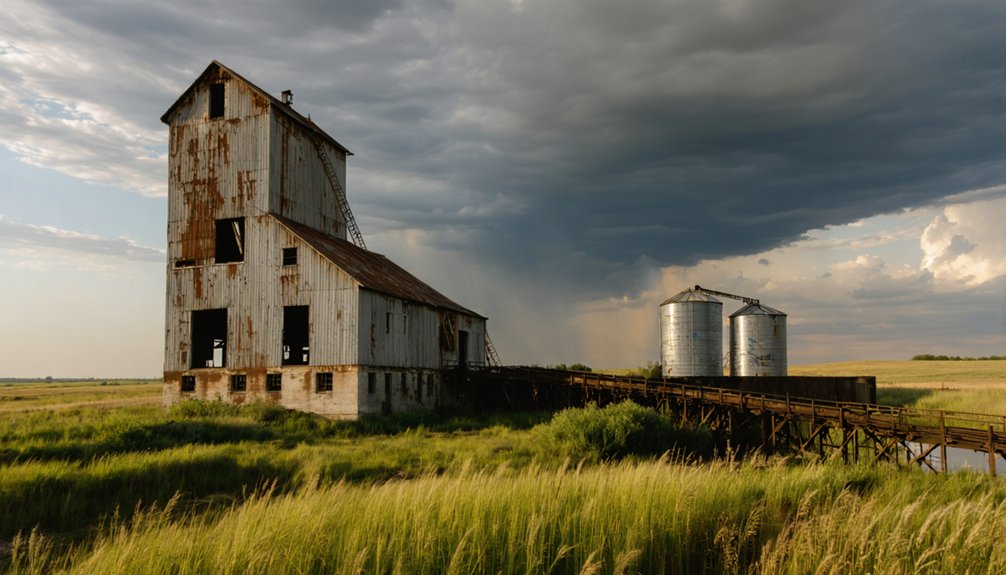
Summit’s gold deposits ignited the town’s rapid growth in the late 1800s, drawing prospectors from Colorado, Montana, and beyond to try their luck at striking it rich.
You’d find the town bustling as an essential railroad hub, with trains hauling precious ore and bringing supplies to the steady stream of fortune seekers.
The surrounding Black Hills forests provided abundant timber resources, supporting a thriving logging industry that complemented the mining operations until both sectors declined in the 20th century.
Mining Drives Town Growth
During the mining boom era, prospectors flocked to South Dakota’s mineral-rich landscape, where gold and silver deposits promised substantial wealth.
You’d find these ambitious pioneers developing specialized mining techniques in the igneous formations of the Black Hills, while also pursuing lesser-known minerals like tin, tungsten, and tantalum. This mineral diversity shaped Summit’s growth and the region’s economic destiny.
- Sophisticated infrastructure emerged, including stamp mills and rock breakers.
- The Homestake Mine showcased cutting-edge technology and massive development.
- Mining operations attracted significant investment and skilled workforce.
- Ancillary businesses flourished, creating a vibrant economic ecosystem.
You can trace Summit’s rise directly to these mining activities, which transformed a rugged frontier into a bustling hub of industry and commerce, though the town’s fortunes would ultimately rise and fall with the mines.
Railroad Hub Development
Beyond the mineral wealth that sparked Summit’s initial growth, the Great Northern Railway‘s transcontinental line transformed this South Dakota settlement into a thriving transportation nexus.
You’d find Summit strategically positioned at a high elevation point, where railroad expansion enabled crucial connections between resource-rich areas and distant markets.
The rail hub revolutionized local agriculture, giving you direct access to affordable shipping for grain and livestock. You could’ve witnessed the bustling activity around grain elevators and warehouses near the rail sidings, where agricultural connectivity flourished.
The railroad company actively shaped Summit’s development, platting the town’s layout around the depot and promoting settlement through land sales and farming guidance.
Those rail lines you’d see stretching across the prairie represented freedom and prosperity for early settlers, linking their remote community to the wider world.
Timber Industry Peak
While the Black Hills region was well-known for its mineral wealth, the local timber industry sparked significant economic development throughout South Dakota’s frontier communities.
The peak of lumber production transformed the landscape as sawmills dotted the region, with Custer alone boasting a dozen mills by 1900.
You’ll find the industry’s rapid growth was marked by:
- John Frances Murphy’s pioneering sawmill in Custer, which established the foundation for regional lumber operations
- Homestake Mining Company’s significant influence on timber prices and forest management practices
- The creation of the Black Hills Forest Reserve in 1897, covering nearly one million acres
- Independent loggers’ essential role in forest thinning and maintenance throughout the twentieth century
The era’s unregulated harvesting eventually led to more sustainable practices, balancing economic prosperity with conservation needs.
The Path to Abandonment
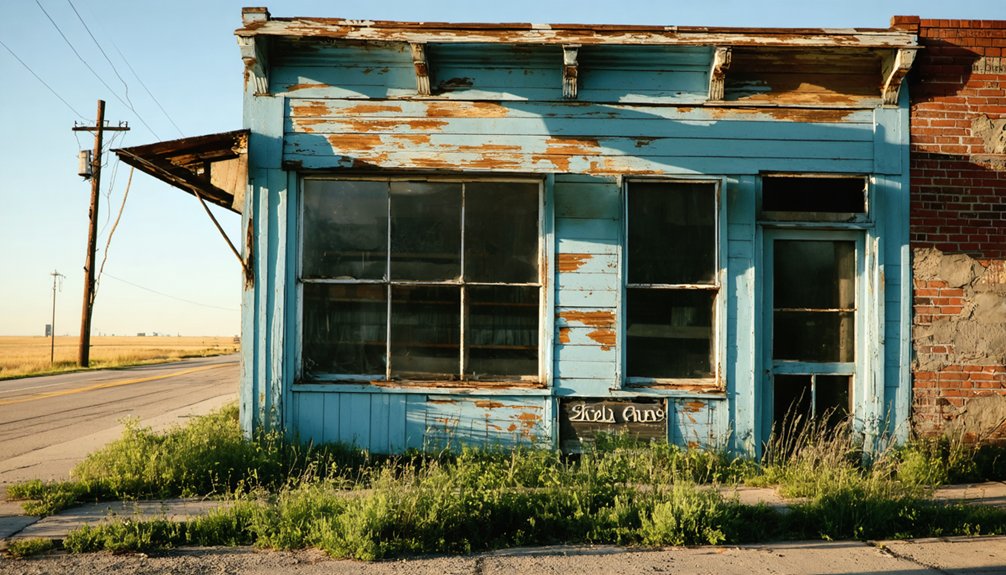
As mining operations in Summit began to falter in the late 1800s, the town’s inevitable decline mirrored the fate of numerous Black Hills settlements.
Despite attempts at community resilience, the lack of economic diversification left Summit vulnerable when mineral prices plummeted and accessible ore depleted. You’d have witnessed the exodus first-hand: miners and their families departed, leaving aging residents behind in an increasingly isolated community.
Once-bustling streets emptied as miners sought opportunities elsewhere, leaving Summit’s aging residents to watch their community slowly fade away.
The removal of railroad lines dealt another crushing blow, as Summit’s lifeline to the outside world slowly vanished.
Essential services disappeared one by one – the post office, schools, and stores couldn’t survive the dwindling population.
The harsh Black Hills environment and mining’s environmental toll made agriculture impossible, while flooding damaged what little infrastructure remained.
Summit’s buildings fell into disrepair, ultimately surrendering to time and the elements.
Architectural Legacy and Remaining Structures
The architectural remnants of Summit tell a compelling story of frontier ingenuity and ambition. As you explore the ghost town’s remaining structures, you’ll discover how settlers adapted to the challenging Black Hills environment through their architectural influences and cultural reflections.
- The town’s falsefront buildings stand as evidence of the optimistic spirit of early merchants, with their imposing facades masking more modest structures behind.
- You’ll find evidence of resourceful construction methods, from sod houses built by early settlers to sturdy brick commercial buildings that arrived with the railroad.
- The chapel remains as one of Summit’s most significant landmarks, its simple wooden frame embodying the community’s spiritual heritage.
- Scattered throughout the site, basement houses and industrial remnants showcase the practical adaptations settlers made to harsh frontier conditions.
Preservation Challenges and Access
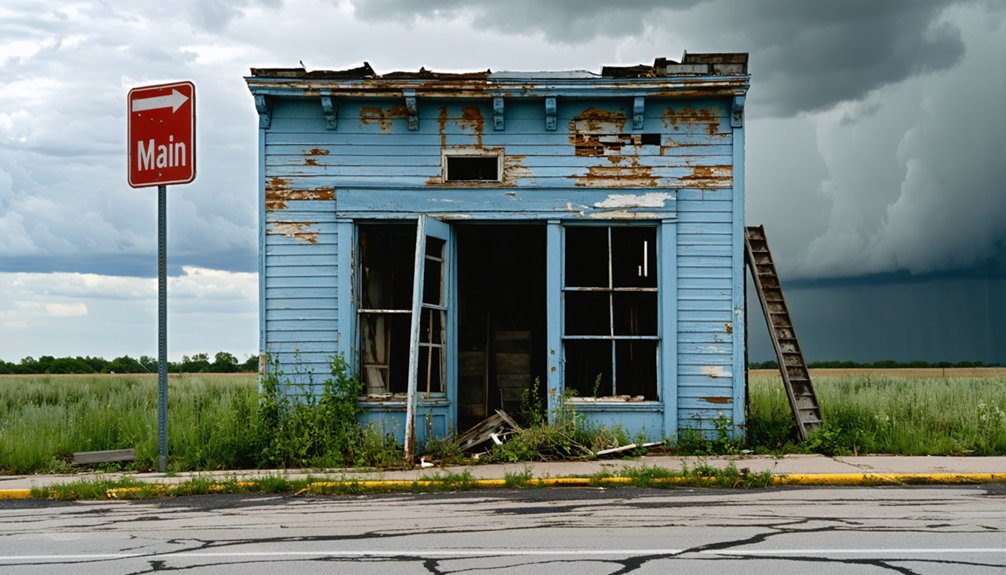
Modern preservation efforts for Summit face complex legal, environmental, and safety challenges that threaten both access and conservation. South Dakota’s strict land inspection laws and eminent domain restrictions complicate preservation strategies, while federal agencies often provide only minimal protection for historically significant sites.
You’ll find access limitations throughout Summit due to deteriorating structures and safety concerns. The ghost town’s remote location and rugged terrain make infrastructure maintenance difficult, while liability issues restrict visitation.
Local tribes actively contest development projects that could damage cultural heritage, adding another layer of complexity to preservation efforts. With less than 6% of federal projects receiving full environmental assessments, Summit’s historical landscape remains vulnerable to both natural decay and potential industrial development in the Black Hills region.
Historical Significance in South Dakota
While preservation challenges mount, Summit’s historical legacy tells a remarkable story of South Dakota’s railroad era. The town’s historical context mirrors the dynamic growth of the Black Hills region during the late 19th century, when railroads transformed the landscape and connected isolated communities to larger markets.
Summit’s economic impact extended beyond its role as a transportation hub:
- Served as a crucial link in the Chicago, Burlington & Quincy railroad network
- Facilitated the movement of essential resources like coal, timber, and livestock
- Supported a thriving community with schools, churches, and local businesses
- Represented the broader pattern of boom-and-bust development common to Black Hills settlements
You’ll find in Summit’s story a microcosm of South Dakota’s transformation from frontier territory to an interconnected economic region.
Summit’s Place in Black Hills Heritage
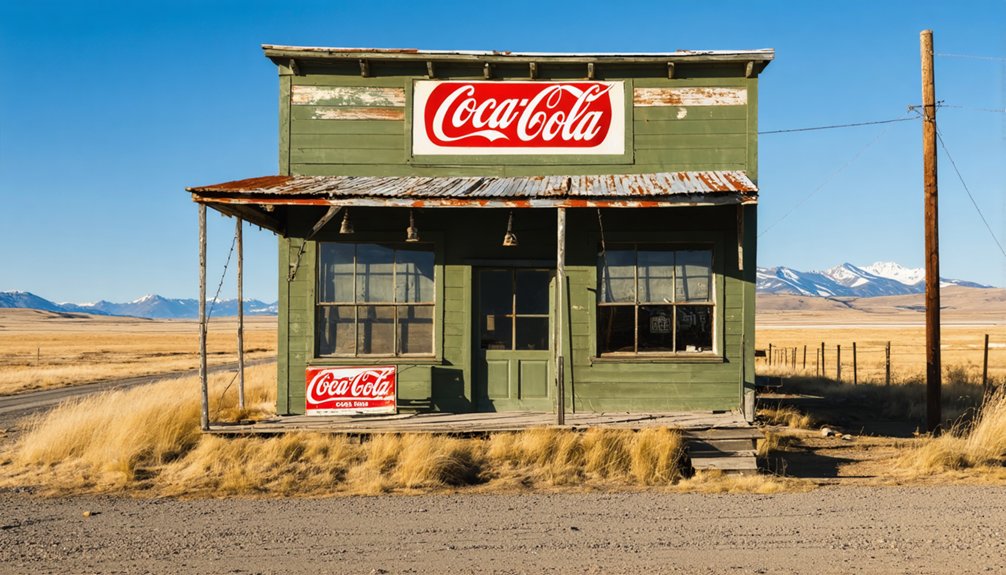
As sacred ground for Native American tribes intersected with settler ambitions, Summit emerged as part of a complex tapestry woven into Black Hills heritage.
You’ll find Summit’s story deeply rooted in the region’s transformation from an area of profound indigenous spirituality to a bustling mining frontier.
While the Lakota Sioux held the Black Hills as central to their cultural heritage, Summit’s development reflected the dramatic shift that occurred after the 1874 Custer expedition.
The sacred Black Hills transformed irreversibly as Summit rose from Lakota lands in the wake of Custer’s fateful expedition.
The town grew during the gold rush era, joining other mining communities that reshaped the landscape.
Today, you can trace Summit’s legacy through preserved mining infrastructure and historic trails, though it stands as a poignant reminder of the collision between Native American traditions and the settler pursuit of mineral wealth that forever changed the Black Hills.
Frequently Asked Questions
Are There Any Reported Ghost Sightings or Paranormal Activities in Summit?
You won’t find documented ghostly encounters in Summit, though locals share unverified stories. While the town’s haunted history intrigues visitors, there’s no concrete evidence of paranormal activity in this remote location.
What Happened to the Personal Belongings Left Behind by Summit’s Last Residents?
Amid dust-covered floorboards and crumbling walls, you’ll find abandoned artifacts slowly decaying – personal histories scattered by time, weather, and scavengers. Many items were likely taken by collectors or destroyed by exposure.
Did Any Notable Crimes or Lawlessness Occur During Summit’s Active Years?
You won’t find documented crime incidents or law enforcement records from Summit’s active period. While frontier lawlessness was common in the region, no specific criminal events were recorded for this town.
Where Did Most of Summit’s Former Residents Relocate After Leaving?
You’ll find no clear records of migration patterns, but economic factors likely drove Summit’s residents to scatter toward larger regional towns, farms, and cities where better opportunities beckoned.
Were There Any Indigenous Settlements in the Summit Area Before Development?
While Indigenous history suggests seasonal movement through the area, you won’t find documented permanent settlements at Summit’s location. Sioux tribes likely passed through following regional settlement patterns and hunting routes.
References
- https://www.sdpb.org/rural-life-and-history/2023-08-21/some-black-hills-ghost-towns-and-their-origins
- https://www.youtube.com/watch?v=Glucs_Rq8Xs
- https://www.youtube.com/watch?v=_0WNYsFLSLA
- https://www.blackhillsbadlands.com/blog/post/old-west-legends-mines-ghost-towns-route-reimagined/
- https://icatchshadows.com/okaton-and-cottonwood-a-photographic-visit-to-two-south-dakota-ghost-towns/
- https://en.wikipedia.org/wiki/List_of_ghost_towns_in_South_Dakota
- https://www.deadwood.com/business/attractions/1880-train/
- https://blackhillsvisitor.com/learn/timeline-of-black-hills-railroads/
- https://www.southdakotamagazine.com/rocky-road
- https://www.railstotrails.org/trailblog/a-milestone-for-the-mickelson-trail-celebrating-25-years/
